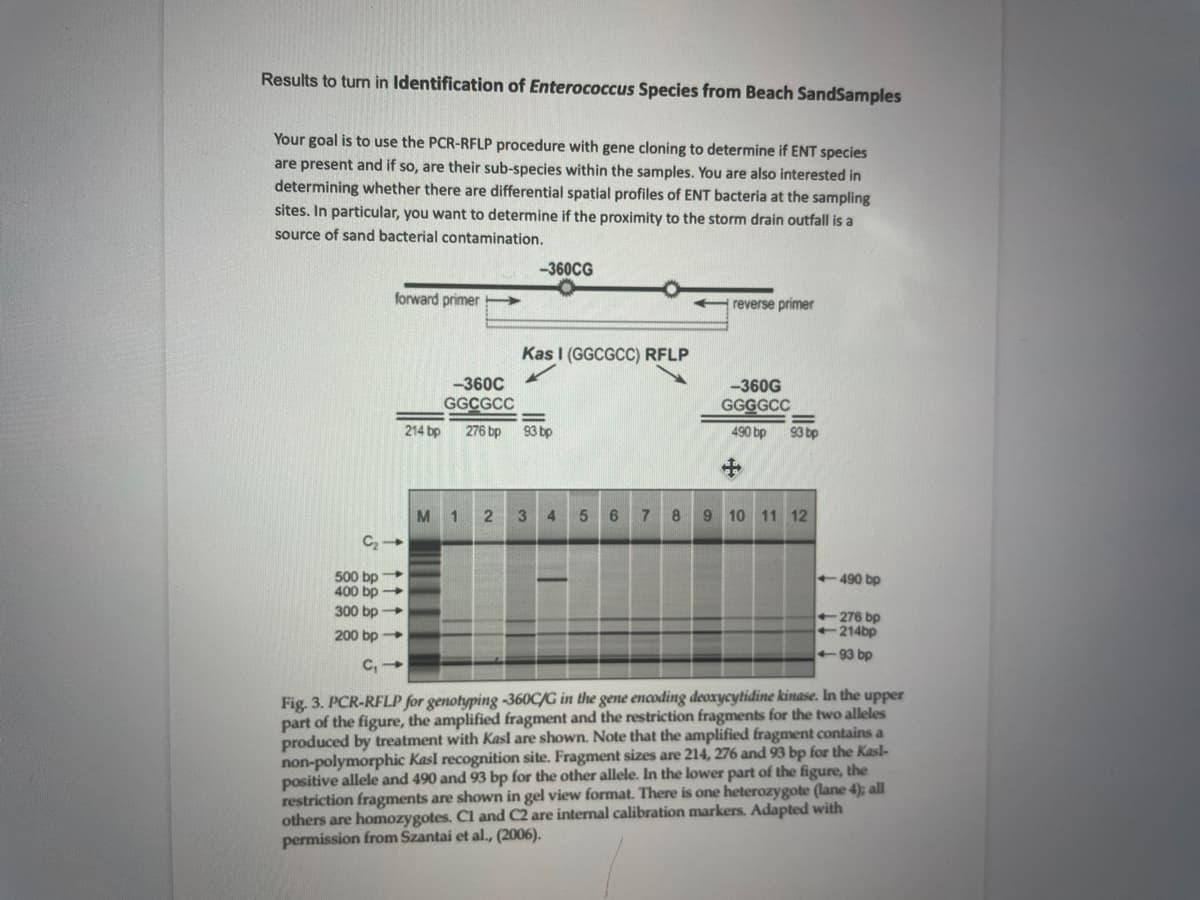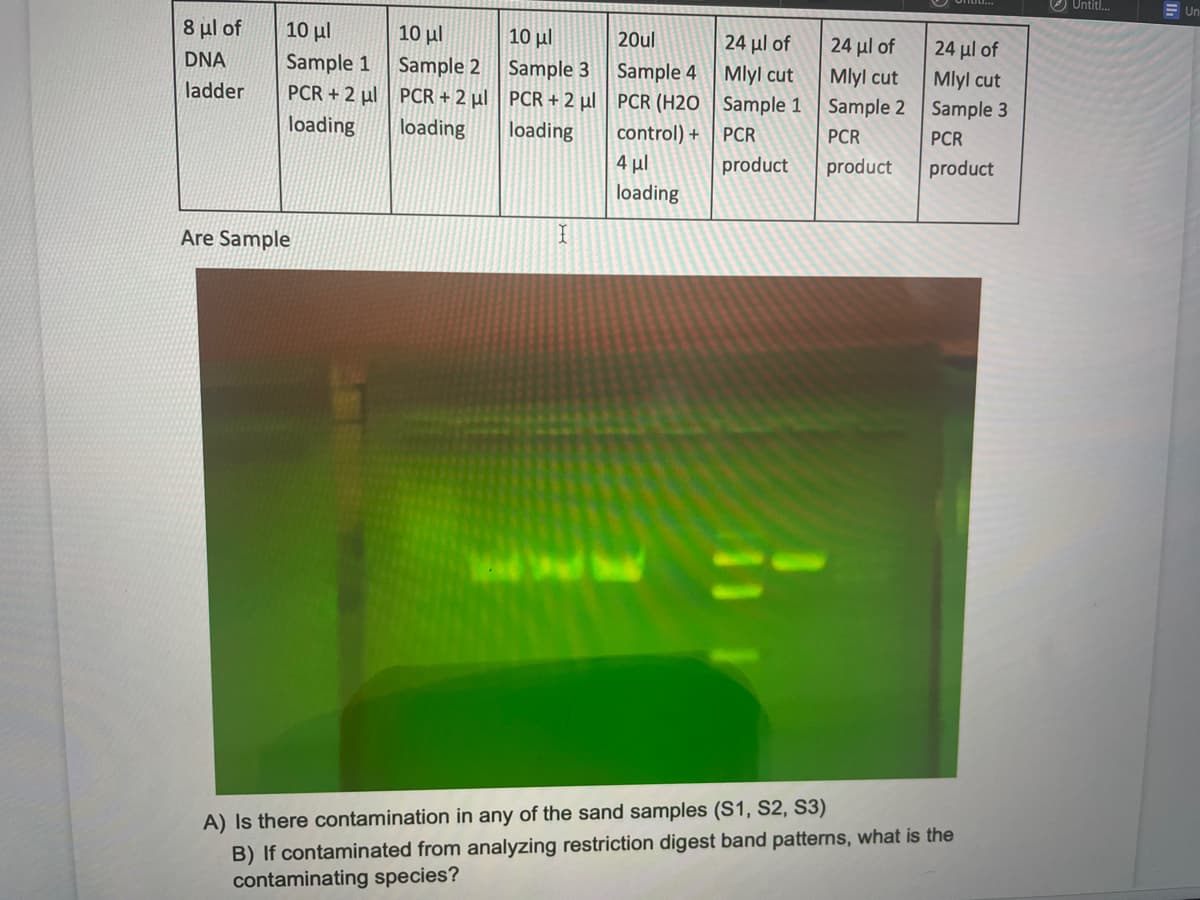Biology: The Unity and Diversity of Life (MindTap Course List)
15th Edition
ISBN:9781337408332
Author:Cecie Starr, Ralph Taggart, Christine Evers, Lisa Starr
Publisher:Cecie Starr, Ralph Taggart, Christine Evers, Lisa Starr
Chapter46: Ecosystems
Section: Chapter Questions
Problem 3CT: Nitrogen-fixing bacteria live throughout the ocean, from its sunlit upper waters to 200 meters (650...
Related questions
Question
How can I tell if there is contamination?

Transcribed Image Text:Results to turn in Identification of Enterococcus Species from Beach SandSamples
Your goal is to use the PCR-RFLP procedure with gene cloning to determine if ENT species
are present and if so, are their sub-species within the samples. You are also interested in
determining whether there are differential spatial profiles of ENT bacteria at the sampling
sites. In particular, you want to determine if the proximity to the storm drain outfall is a
source of sand bacterial contamination.
-360CG
forward primer
reverse primer
Kas I (GGCGCC) RFLP
-360C
-360G
GGCGCC
GGGGCC
214 bp
276 bp
93 bp
490 bp
93 bp
м 1
3
4.
5 6
8
9 10 11 12
C2
500 bp
400 bp
+490 bp
300 bp
-276 bp
214bp
200 bp
-93 bp
C,
Fig. 3. PCR-RFLP for genotyping -360C/G in the gene encoding deoxycytidine kinase. In the upper
part of the figure, the amplified fragment and the restriction fragments for the two alleles
produced by treatment with Kasl are shown. Note that the amplified fragment contains a
non-polymorphic Kasl recognition site. Fragment sizes are 214, 276 and 93 bp for the Kasl-
positive allele and 490 and 93 bp for the other allele. In the lower part of the figure, the
restriction fragments are shown in gel view format. There is one heterozygote (lane 4); all
others are homozygotes. Cl and C2 are internal calibration markers. Adapted with
permission from Szantai et al., (2006).

Transcribed Image Text:O Untitl.
E Un
8 μΙ f
10 µl
10 µl
10 μι
Sample 2 Sample 3
20ul
24 µl of
Mlyl cut
24 µl of
24 µl of
DNA
Sample 1
Sample 4
PCR + 2 µl PCR + 2 µl PCR + 2 µl PCR (H2O Sample 1 Sample 2 Sample 3
Mlyl cut
Mlyl cut
ladder
loading
loading
loading
control) +
4 µl
PCR
PCR
PCR
product
product
product
loading
Are Sample
A) Is there contamination in any of the sand samples (S1, S2, S3)
B) If contaminated from analyzing restriction digest band patterns, what is the
contaminating species?
Expert Solution
This question has been solved!
Explore an expertly crafted, step-by-step solution for a thorough understanding of key concepts.
This is a popular solution!
Trending now
This is a popular solution!
Step by step
Solved in 2 steps

Knowledge Booster
Learn more about
Need a deep-dive on the concept behind this application? Look no further. Learn more about this topic, biology and related others by exploring similar questions and additional content below.Recommended textbooks for you

Biology: The Unity and Diversity of Life (MindTap…
Biology
ISBN:
9781337408332
Author:
Cecie Starr, Ralph Taggart, Christine Evers, Lisa Starr
Publisher:
Cengage Learning

Biology: The Unity and Diversity of Life (MindTap…
Biology
ISBN:
9781337408332
Author:
Cecie Starr, Ralph Taggart, Christine Evers, Lisa Starr
Publisher:
Cengage Learning